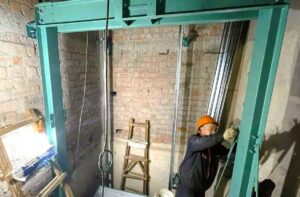Reducing Production Lead Time for Elevators
In today’s fast-paced world, reducing production lead time is crucial, especially in the elevator industry. Long lead times can result in missed deadlines, increased costs, and unhappy customers. By understanding and implementing the right strategies, companies can significantly shorten these timelines, enhancing efficiency and customer satisfaction. This article delves into the secrets of reducing production lead time for elevators, providing valuable industry insights that can help manufacturers stay ahead in the competitive market.
Understanding Production Lead Time
Production lead time is the period between the initiation of the production process and the completion of the product. In the elevator industry, this includes everything from design and material procurement to assembly and testing. Longer lead times can be detrimental, leading to delays in project completion and increased costs. By understanding the components that contribute to lead time, companies can identify areas for improvement.
Typically, 30-45 days after the approval of drawings, your elevator will be complete and ready to ship. This promise of efficiency and precision is not just about beating the clock but about ensuring that every customer receives a product that meets the highest standards of quality and reliability. This commitment to excellence, coupled with a relentless pursuit of innovation, sets the stage for a future where elevators are not just means of transportation but symbols of human ingenuity and technological advancement.
Fixing the traction motor usually takes one to two weeks, integrating the motherboard and inverter with the elevator controller takes about two to three weeks, and cutting and bending stainless steel sheets to prepare the elevator cab typically takes around one week. Accumulating information on counterweights and guide rails requires approximately two weeks. Arranging and installing electrical components such as the COP, LOP, buttons, plug-in cables, machine room wiring, traveling cables, pit stop switches, junction boxes, intercom systems, and door operators typically takes about two to three weeks. By efficiently managing these crucial steps, companies can significantly reduce lead time and enhance overall production efficiency.
Reducing Lead Time for Assembling
Fixing the Traction Motor
Fixing the traction motor is a critical step in elevator production. On average, this process takes about one to two weeks. By ensuring that all necessary parts are readily available and that technicians are well-trained, this timeframe can be minimized, preventing delays in the overall production process.
Producing an Integrated Controller
Integrating the motherboard and inverter with the elevator controller is another crucial task. This typically takes about one to two weeks, depending on the complexity of the system. Streamlining this integration through the use of modular components and standardized procedures can significantly reduce this time. Not all the elevator supplier produce it from same factories, sometimes they does OEM from others.
Cutting and Bending Stainless Steel Sheets
Preparing the elevator cab involves cutting and bending stainless steel sheets. This process usually takes around one week. Utilizing advanced machinery and automation can speed up this step, ensuring that the cabs are ready for assembly without unnecessary delays.
Manufacturing Electrical Components
Sometimes this item could be on stock or sourced. If not, then manufacturing and installing electrical components such as the Car Operating Panel (COP), Landing Operating Panel (LOP), buttons, all plug-in cables, machine room wiring, traveling cables, pit stop switches, junction boxes, intercom systems, and door operators is a meticulous task. This process, vital for the elevator’s functionality and safety, typically takes about two to three weeks. By using pre-assembled kits and standardized wiring procedures, this timeline can be significantly reduced, ensuring a smoother and faster installation phase.
Accumulating Counterweights & Guide Rails
Gathering counterweights and guide rails is essential for the safe and efficient operation of elevators. This phase can take approximately two to three days if manufacturers are procuring from different soucre, as it involves precise calculations and sourcing the right materials. Leveraging data management systems and maintaining strong supplier relationships can expedite this process.

a) Importance of Reducing Lead Time
Reducing lead time is not just about faster production. It’s about improving overall efficiency, reducing costs, and enhancing customer satisfaction. Shorter lead times mean quicker delivery to customers, which can be a significant competitive advantage. Additionally, it allows for better inventory management and reduced storage costs.
Streamlining Design Processes
The design phase is often the first bottleneck in production. Streamlining this process can have a significant impact on overall lead time. Implementing advanced design software and collaborative tools can help teams work more efficiently. By standardizing designs where possible and minimizing customizations, companies can reduce the time spent on design adjustments and approvals.
Efficient Material Procurement
Material procurement is another critical factor in lead time. Delays in receiving materials can halt production. Establishing strong relationships with reliable suppliers and implementing a just-in-time (JIT) inventory system can help ensure that materials are available when needed. Additionally, leveraging technology for supply chain management can provide real-time updates on material availability and delivery schedules.
Automating Production Processes
Automation is a game-changer in reducing lead time. By automating repetitive and time-consuming tasks, companies can significantly speed up production. Robotic assembly lines, automated quality control systems, and smart manufacturing technologies can all contribute to faster and more efficient production processes.
Enhancing Workforce Training
A well-trained workforce is essential for efficient production. Investing in regular training programs for employees ensures that they are skilled in the latest technologies and processes. This not only improves productivity but also reduces the likelihood of errors that can cause delays.
b) Implementing Lean Manufacturing Principles
Lean manufacturing is a methodology focused on minimizing waste and maximizing efficiency. By adopting lean principles, companies can streamline their production processes, reducing lead time. This includes techniques such as value stream mapping, continuous improvement (Kaizen), and 5S (Sort, Set in order, Shine, Standardize, Sustain).
Improving Communication and Collaboration
Effective communication and collaboration are crucial in reducing lead time. Ensuring that all departments are aligned and working towards the same goals can prevent misunderstandings and delays. Using project management tools and regular meetings to update progress and address issues can keep everyone on the same page.
Utilizing Data Analytics
Data analytics can provide valuable insights into production processes, helping identify bottlenecks and areas for improvement. By collecting and analyzing data on various aspects of production, companies can make informed decisions to optimize their processes. Predictive analytics can also help anticipate potential issues before they become major problems, allowing for proactive measures to reduce lead time.
Emphasizing Quality Control
While speeding up production, it’s crucial not to compromise on quality. Implementing robust quality control measures throughout the production process can help identify defects early, preventing costly rework and delays. Automated quality control systems can provide consistent and accurate inspections, ensuring that only high-quality products move to the next stage of production.
Adopting Agile Project Management
Agile project management techniques, commonly used in software development, can also be applied to the elevator industry. This approach focuses on flexibility, continuous feedback, and iterative progress, allowing for adjustments to be made quickly as needed. By breaking down the production process into smaller, manageable segments, companies can reduce lead time and improve overall efficiency.
c) Case Studies: Success Stories in Reducing Lead Time
Case Study 1: Schindler Group
The Schindler Group, a leading global elevator manufacturer, implemented several strategies to reduce their production lead time. By adopting lean manufacturing principles and automating key processes, they were able to reduce lead time by 20%. Additionally, their investment in workforce training and development ensured that their employees were proficient in the latest technologies, further enhancing efficiency.
Case Study 2: Otis Elevator Company
Otis Elevator Company focused on improving their supply chain management to reduce lead time. By establishing strong relationships with reliable suppliers and implementing a just-in-time inventory system, they significantly decreased delays in material procurement. Their use of data analytics provided valuable insights into their production processes, helping them identify and address bottlenecks effectively.
Case Study 3: Nidec Elevator
Nidec Elevator provides one stop solution from single source. It leveraged advanced design software and collaborative tools to streamline their design process. By standardizing designs and minimizing customizations, they reduced the time spent on design adjustments and approvals. Their emphasis on quality control throughout the production process ensured that defects were identified early, preventing delays and costly rework.
Future Trends in Reducing Production Lead Time
The elevator industry is continually evolving, with new technologies and methodologies emerging to further reduce production lead time. Industry 4.0, characterized by the integration of digital and physical systems, offers exciting possibilities for the future. Smart factories, leveraging the Internet of Things (IoT), artificial intelligence (AI), and machine learning, can optimize production processes and further reduce lead time. Additionally, additive manufacturing (3D printing) holds promise for producing customized parts quickly and efficiently, further enhancing the speed and flexibility of production.
Conclusion
Reducing production lead time is crucial for the elevator industry to remain competitive and meet customer demands. By streamlining design processes, automating production, enhancing workforce training, and adopting lean manufacturing principles, companies can significantly shorten their production timelines. Effective communication, data analytics, and quality control are also essential in this endeavor.
By staying abreast of emerging trends and technologies, elevator manufacturers can continue to improve their processes and deliver high-quality products efficiently. Implementing these strategies not only boosts productivity but also ensures customer satisfaction, paving the way for long-term success in the industry.



